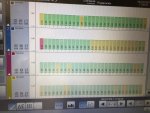Recently attempted to create a DMAXX icc profile, but to no avail. My software (admittedly dated...PrintOpen v4...oky, waaaay dated!) seems not to be capable of the task.
When measuring printed targets, nearly all patches are accompanied with the warning of "significant declinations".
The resulting profile, when viewed with the ColorSync Utility, shows a misshapen 3D color space.
Would anyone here know why that is?
Meanwhile, I'll resort to downloading Idealliance's XCMYK profile.
When measuring printed targets, nearly all patches are accompanied with the warning of "significant declinations".
The resulting profile, when viewed with the ColorSync Utility, shows a misshapen 3D color space.
Would anyone here know why that is?
Meanwhile, I'll resort to downloading Idealliance's XCMYK profile.













